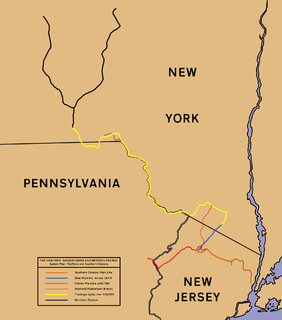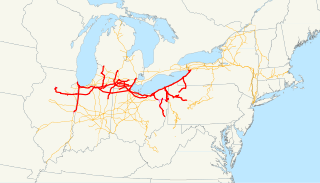Related Research Articles

The New York Central Railroad was a railroad primarily operating in the Great Lakes and Mid-Atlantic regions of the United States. The railroad primarily connected greater New York and Boston in the east with Chicago and St. Louis in the Midwest along with the intermediate cities of Albany, Buffalo, Cleveland, Cincinnati, Detroit, and Syracuse. New York Central was headquartered in New York City's New York Central Building, adjacent to its largest station, Grand Central Terminal.

The Delaware, Lackawanna & Western Railroad was a U.S. Class 1 railroad that connected Buffalo, New York, and Hoboken, New Jersey, a distance of about 400 miles (640 km). Incorporated in 1853, the DL&W was profitable during the first two decades of the twentieth century, but its margins were gradually hurt by declining traffic in coal and competition from trucks. In 1960, the DL&W merged with rival Erie Railroad to form the Erie Lackawanna Railroad.

The New York, Susquehanna and Western Railway is a Class II American freight railway operating over 400 miles (645 km) of track in the northeastern U.S. states of New York, Pennsylvania, and New Jersey.

The Rome, Watertown and Ogdensburg Railroad was a railroad that grew, in stages, from Rome, New York to Watertown and then to Ogdensburg, New York and Massena, New York. The original Rome and Watertown Railroad terminated in Cape Vincent, NY on the St Lawrence River. A branch of the Rome, Watertown and Ogdensburg Railroad, commonly known as The Hojack Line, operated along the south shore of Lake Ontario, from Oswego, New York to Niagara Falls, New York.

The Lake Shore and Michigan Southern Railway, established in 1833 and sometimes referred to as the Lake Shore, was a major part of the New York Central Railroad's Water Level Route from Buffalo, New York, to Chicago, Illinois, primarily along the south shore of Lake Erie and across northern Indiana. The line's trackage is still used as a major rail transportation corridor and hosts Amtrak passenger trains, with the ownership in 1998 split at Cleveland between CSX to the east, and Norfolk Southern in the west.
The United New Jersey Railroad and Canal Company (UNJ&CC) was a railroad company which began as the important Camden & Amboy Railroad (C&A), whose 1830 lineage began as one of the eight or ten earliest permanent North American railroads, and among the first common carrier transportation companies whose prospectus marketed an enterprise aimed at carrying passengers fast and competing with stagecoaches between New York Harbor and Philadelphia-Trenton. Among the other earliest chartered or incorporated railroads, only the Mohawk and Hudson Railroad and Baltimore and Ohio Railroad were chartered with passenger services in mind. Later, after mergers, the UNJ&CC became a subsidiary part of the Pennsylvania Railroad (PRR) system in New Jersey by the later merger and acquisition of several predecessor companies in 1872; these purchases also included the PRR's main line to New York City. Prior to 1872, its main lines were the Camden and Amboy Rail Road and Transportation Company, the first railroad in New Jersey and one of the first railroads in the United States.

The Boston and Albany Railroad was a railroad connecting Boston, Massachusetts to Albany, New York, later becoming part of the New York Central Railroad system, Conrail, and CSX Transportation. The line is currently used by CSX for freight. Passenger service is still provided on the line by Amtrak, as part of their Lake Shore Limited service, and by the MBTA Commuter Rail system, which owns the section east of Worcester and operates it as its Framingham/Worcester Line.
The Oswego and Syracuse Railroad was formed April 29, 1839, and the route was surveyed during the summer of that year. The Company was fully organized March 25, 1847. The road was opened on May 14, 1848, and ran a total distance of 35.5 miles (57.1 km) from Syracuse, New York to Oswego, New York. In 1872 it passed under the management of the Delaware, Lackawanna and Western Railroad.
The Rochester and Syracuse Railroad was incorporated on August 1, 1850. The Auburn and Rochester Railroad Company was incorporated May 13, 1836, and opened in August 1841. The Auburn and Syracuse Railroad Company was incorporated May 1, 1834, and opened in June 1838. Both railroads combined on August 1, 1850, and the consolidated company constructed the Direct Railway between Syracuse and Rochester.
Te Auburn and Rochester Railroad was a railroad company based in New York state in the 19th century.

The West Shore Railroad was the final name of a railroad that ran from Weehawken, New Jersey, which is across the Hudson River from New York City, north along the west shore of the river to Albany, New York, and then west to Buffalo. It was organized as a competitor to the New York Central and Hudson River Railroad, but was soon taken over by that company.
The Auburn and Syracuse Railroad was incorporated on May 1, 1834, to provide easy access between Syracuse, New York, and the Erie Canal. Construction was begun in 1835, however, was delayed during the Panic of 1837. Although the economic downturn lingered until 1843, the railroad was completed by January 1838.

New York State Railways was a subsidiary of the New York Central Railroad that controlled several large city streetcar and electric interurban systems in upstate New York. It included the city transit lines in Rochester, Syracuse, Utica, Oneida and Rome, plus various interurban lines connecting those cities. New York State Railways also held a 50% interest in the Schenectady Railway Company, but it remained a separate independent operation. The New York Central took control of the Rochester Railway Company, the Rochester and Eastern Rapid Railway and the Rochester and Sodus Bay Railway in 1905, and the Mohawk Valley Company was formed by the railroad to manage these new acquisitions. New York State Railways was formed in 1909 when the properties controlled by the Mohawk Valley Company were merged. In 1912 it added the Rochester and Suburban Railway, the Syracuse Rapid Transit Railway, the Oneida Railway, and the Utica and Mohawk Valley Railway. The New York Central Railroad was interested in acquiring these lines in an effort to control the competition and to gain control of the lucrative electric utility companies that were behind many of these streetcar and interurban railways. Ridership across the system dropped through the 1920s as operating costs continued to rise, coupled with competition from better highways and private automobile use. New York Central sold New York State Railways in 1928 to a consortium led by investor E. L. Phillips, who was looking to gain control of the upstate utilities. Phillips sold his stake to Associated Gas & Electric in 1929, and the new owners allowed the railway bonds to default. New York State Railways entered receivership on December 30, 1929. The company emerged from receivership in 1934, and local operations were sold off to new private operators between 1938 and 1948.
The Syracuse and Utica Railroad was chartered May 1, 1836, and had to pay the state for any freight displaced from the Erie Canal. The full line opened July 4, 1839, extending the line further to Syracuse, New York to Rome, New York. The road was consolidated into the New York Central Railroad in 1853.
The Mohawk Subdivision is a railroad line owned by CSX Transportation in the U.S. state of New York. The line runs from Amsterdam, NY west to Oneida, NY along the former New York Central Railroad main line. At its east end, east of downtown Amsterdam, the line becomes the Selkirk Subdivision. With the creation of the CSX Syracuse Terminal Subdivision the west end is at Oneida, New York.
The Railroad industry in Syracuse, New York got its start in October 1831 when a convention held in the city marked one of the earliest moves to stimulate the era of railroad building which ultimately brought steam railroad service to New York State.
The Syracuse and Binghamton Railroad was established on August 18, 1851, and opened for business on October 18, 1854. The road merged in 1856 into Syracuse and Southern Railroad which was renamed to Syracuse, Binghamton and New York Railroad when the company reorganized after foreclosure in 1857.
The Syracuse Northwestern Railroad was established in 1874 and ran from Woodard to Haymarket Square in Syracuse, New York. The road was consolidated under the Syracuse, Phoenix and Oswego Railroad in 1875 and was sold under a judgement in 1885 under the name Syracuse, Phoenix and Oswego Railway.
Chartered in 1904 by the Beebe Syndicate, the Auburn and Northern Electric Railroad connected the city of Auburn, New York, with the Rochester, Syracuse and Eastern Railroad at Port Byron, New York. The New York Board of Railroad Commissioners authorized construction and a $1 million mortgage to the A&N in 1905 so it could build 12 miles (19 km) of track between Auburn and Port Byron. Lease of the line to be used by A&N was negotiated at an Auburn and Syracuse Electric Railroad stockholders' meeting in May 1907. Construction of the line was contested by the Lehigh Valley Railroad who initiated a frog war when the A&N tried to build a crossing at its tracks; the A&N obtained an injunction and continued building. The railroad began operation in 1908. Lehigh Valley Railroad kept the crossing as a point of contention with an order from the railroad commission in 1909 requiring the A&N to install and operate derails at the crossing.
The Lewiston Railroad Company was an early railroad in Lewiston, NY, running to Niagara Falls, NY. The railroad eventually became a part of the New York Central Railroad system.
References
- ↑ "Railroad Lines here in 1839 Merged into Central". Syracuse Journal . Syracuse, New York. March 20, 1939.
- 1 2 3 4 Agreement. New York Central Railroad, 1853, pg.28. 1879. Retrieved February 13, 2011.